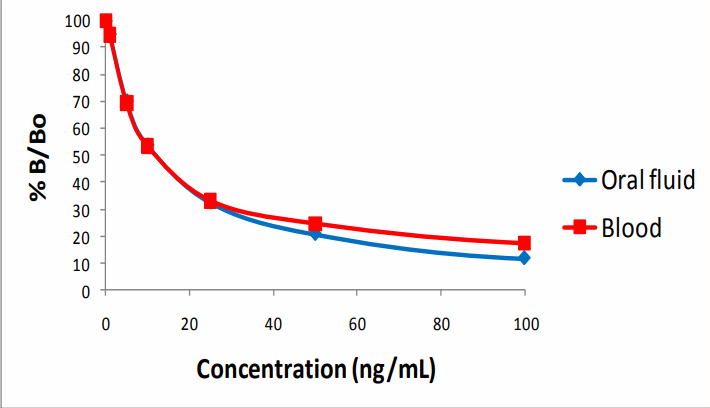Abstract
Tapentadol (Nucynta®) is a centrally acting analgesic and a µ-opioid receptor agonist. It was synthesized as a structural analog to tramadol and has the same pharmacological activity. The structures are shown below. Abuse potential and addiction to tapentadol is similar to hydromorphone (1-2). Oral fluid has become an important testing matrix for therapeutic drug monitoring. Oral fluid specimens are collected using the Quantisal® device, which collects 1 mL of neat oral fluid, which is then diluted with 3 mL of a stabilization buffer in the device. This study describes the first tapentadol specific ELISA method using oral fluid and blood.

Objective
Currently there are no screening methods available for detection of tapentadol in either oral fluid or blood. LCMS/MS methods have been developed for oral fluid and urine and we have also recently developed a homogeneous assay screening method for urine. The goal of this study was to provide toxicologists with an alternate tapentadol screening matrix: oral fluid and blood.
Assay method
- Tapentadol antigen was used to generate tapentadol specific polyclonal antibodies through immunization of rabbits.
- Tapentadol IgG was immobilized on microtiter plates for the assay.
- Oral fluid calibration curve was prepared at levels of 4, 20, 40, 100, 200, 400 and 1000 ng/mL in negative oral fluid and diluted 1:4 with saliva extraction buffer to mimic the Quantisal® collection device.
- Blood curve was prepared at levels of 1, 5, 10, 25, 50 and 100 ng/mL in synthetic negative blood (after 1:10 dilution with PBS buffer).
- The sample sizes used were 10 µL for oral fluid and 25 µL for blood (after 1:10 sample dilution).
- Tapentadol-HRP enzyme conjugate volume was 100 µL.
- The assay is colorimetric, TMB was used as substrate reagent and stopped with 1N HCl.
- Final absorbance was measured by a plate reader, at dual wavelengths of 450 and 650 nm.
Results
Recommended assay cutoffs:
100 ng/mL neat oral fluid
25 ng/mL blood

Cross-reactivity

* ND = not detected
Assay validation
Validation included intra-day (n=8) and inter-day (n=80) precision studies (<10% CV) for oral fluid and blood at 5, 10 and 25 ng/mL.
25 negative oral fluid specimens were fortified with tapentadol at varying concentrations from 0.8-240 ng/mL. No false positives or negatives were observed.
22 negative blood specimens were fortified with tapentadol at varying concentrations from 0.5-200 ng/mL. No false positives or negatives were observed.
Summary
This paper describes a highly sensitive and specific ELISA method for detection of tapentadol in oral fluid and blood. No immunoassay screening method is available yet for oral fluid. This assay would provide toxicologists with a reliable ELISA screen for monitoring tapentadol in oral fluid and blood.
References
- Determination of tapentadol and its metabolite N- desmethyltapentadol in urine and oral fluid using liquid chromatography with tandem mass spectral detection, Coulter C., Taruc M., Tuyay J., Moore C. J. Anal. Toxicol. 2010, 34, 458-463.
- Tapentadol in pain management :a µ-opioid receptor agonist and noradrenaline reuptake inhibitor, Hartrick C.T., Rozek R.J. CNS Drugs, 2011, 25(5), 359-370.
To view the full study and its data, visit this link.
Looking for a unit for your ELISA technique and other related applications? Check out our featured products below.


